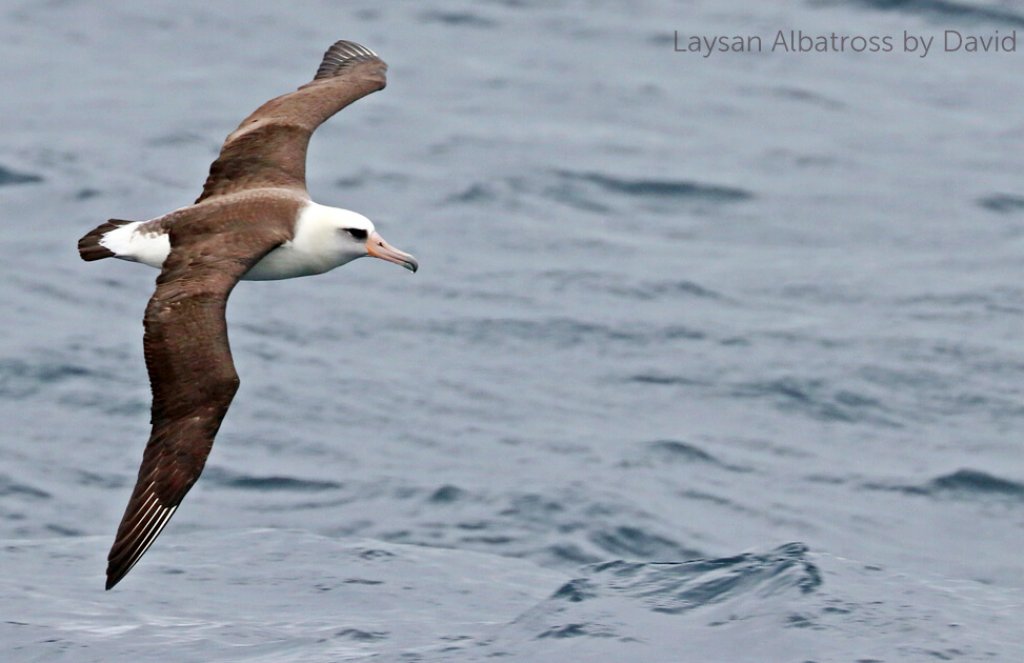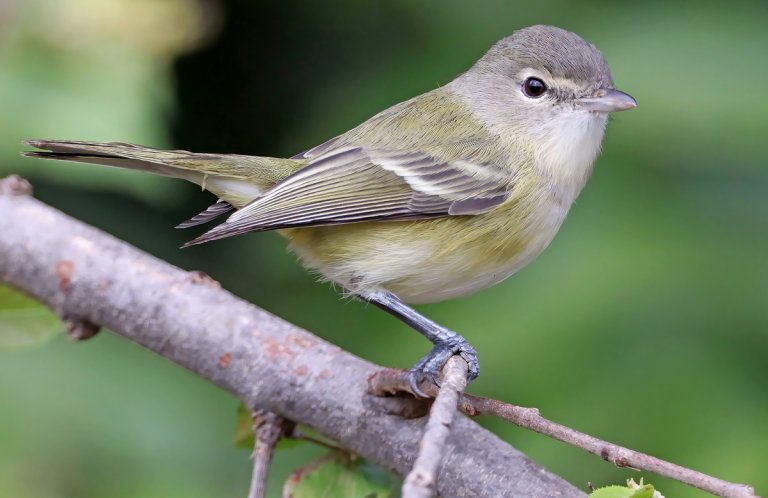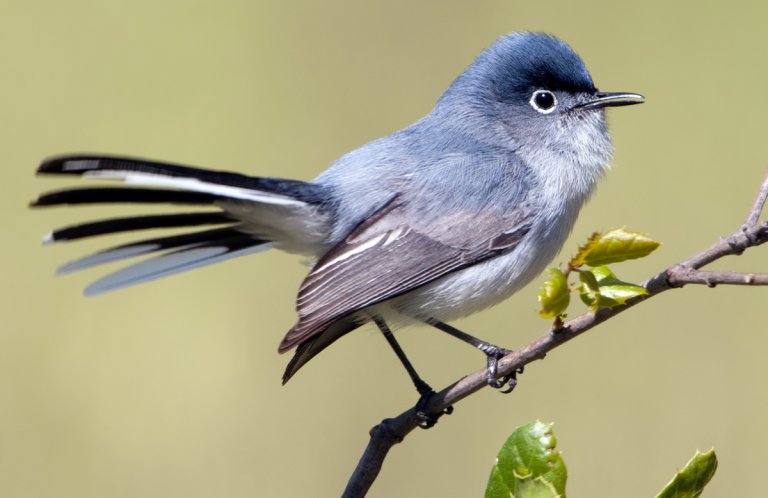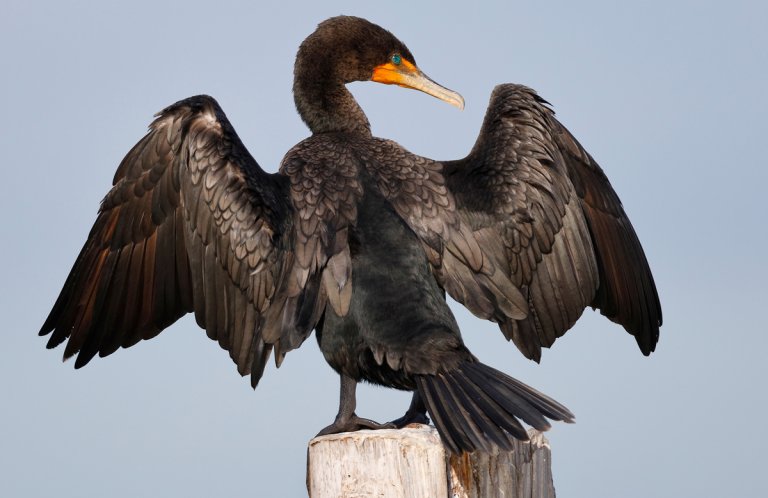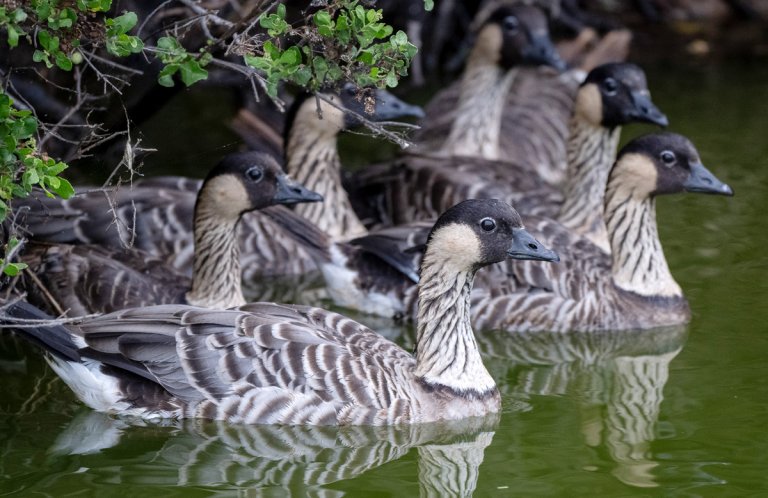
Laysan Albatross range map by ABC.
An inspiring flyer, the Laysan Albatross (known as Mōlī in Hawaiian) can glide over the open ocean for hours at a time without a single flap of its long, narrow wings, sailing hundreds of miles a day on an impressive six-foot span.
This albatross species is named for the Laysan breeding colony in the Northwestern Hawaiian Islands. It is one of the most common seabirds in this remote area of the world, and pairs mate for life.
Like the Black-footed and Short-tailed Albatross, the Laysan takes a long time to mature, only beginning to breed at three or four years old, although successful breeding usually only occurs at eight or nine years of age. This species is also very long-lived. In fact, one of the world's oldest confirmed wild birds is a Laysan Albatross.
Worldly Wisdom
A wild female Laysan Albatross dubbed "Wisdom" is the oldest confirmed wild bird in the world. Wisdom also holds the title of the planet's oldest known banded bird. She was first banded in 1956 at the Midway Atoll National Wildlife Refuge by the late Chandler Robbins, an influential ornithologist and senior scientist at the United States Geological Survey (USGS). Wisdom was already mature when she was first banded, so she is at least 70 years old today.
USGS scientists estimate that Wisdom has flown over 3 million miles since 1956 — a distance equaling about 120 laps around Earth! This amazing albatross has laid 30 to 40 eggs and raised the same number of chicks in her lifetime. She has successfully hatched a chick every year since 2006, most recently in 2021.
Wandering Widely
The majority of Laysan Albatrosses breed in the Hawaiian archipelago, mainly on Midway Atoll and Laysan Island. A small number nest off Japan. In the 1980s, this albatross species also began to nest on islands off the west coast of Mexico, a range extension of thousands of miles.
During the winter, the Laysan Albatross wanders widely, from the Aleutian Islands and Bering Sea all the way across the Pacific Ocean. Birds spend nearly half their year at sea, only coming to land to breed.
Although the Laysan Albatross doesn't "sing" in the usual sense, while on its breeding grounds, it does produce a weird assortment of yelps, whinnies, moans, bill-claps, and squeaks. In flight, though, this bird is generally silent.
Listen to a pair of courting Laysan Albatrosses here:
(Audio: david m, XC116582. Accessible at www.xeno-canto.org/116582)
Genuine “Lovebirds”
Laysan Albatrosses begin forming pair bonds at age three or four years old. Like other large birds, such as the Trumpeter Swan and Whooping Crane, pairs mate for life, although a bird will replace a partner that goes missing. Even if they winter apart, Laysan Albatross pairs reconnect on the same breeding grounds each year, usually by late fall.
Like many seabirds such as the Atlantic Puffin and Royal Tern, the Laysan Albatross is a colonial nester. Colonies can number in the tens of thousands of pairs; the biggest colony, on Midway Atoll, numbers over 600,000 breeding pairs — over 70 percent of the world population of this species!
Young Laysan Albatrosses searching for mates engage in complicated courtship displays, or "dances," which involve up to 25 different postures, from clicking beaks together to pointing them at the sky simultaneously. Established albatross pairs forego these displays and settle down to nest immediately.
A successful Laysan pair produces just one egg per season. If an egg is lost, it is not replaced. Most adult Laysan Albatrosses breed annually, although some pairs, including those of younger birds, may skip a year between breeding attempts. It takes a lot of energy to produce the large egg, and males take over incubation for three-plus weeks straight, so non-nesters may be birds that did not arrive back in prime condition to fulfill these arduous tasks. The nest, created by the female, is a simple scrape with a slight rim to keep the egg from rolling away. Both parents play roles in incubating their egg and tending the single chick, which they feed by regurgitation. Fledging occurs five to six months after hatching. Once they make their first flight, juveniles remain at sea for three to five years.
Surface Feeder
The Laysan Albatross forages while floating on the ocean's surface, feeding mainly on small squid, flying fish eggs, fish, and crustaceans. It will also scavenge carrion and refuse, and will follow fishing boats, sometimes with fatal effect (see conservation section below).
A Laysan Albatross's eyes contain high levels of a pigment called rhodopsin, which enhances night vision, enabling effective nocturnal foraging.
Like other seabirds, this albatross has salt glands and a "tube nose," which allows it to expel excess salt it ingests with its prey.
Continuing Conservation Challenges
Plastic pollution is an increasing threat to the Laysan Albatross and other seabirds, even on the remote islands where these birds breed. Albatrosses pick up most plastics while foraging, either because they mistake a plastic item for food or scoop it up inadvertently while capturing actual prey. They may even regurgitate plastics while feeding their chicks.
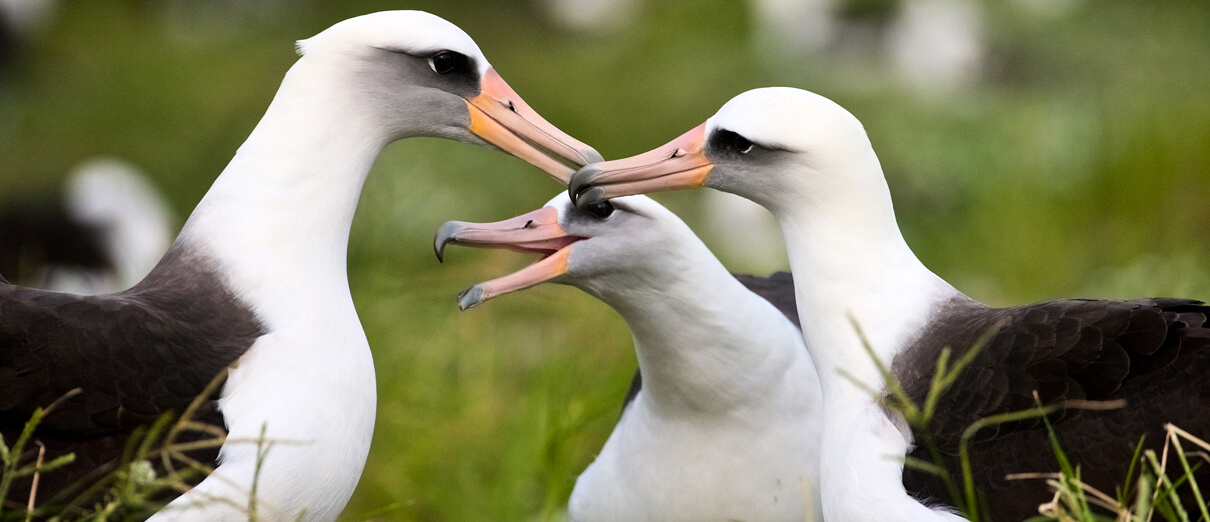
Laysan Albatrosses. Photo by Enrique Aguirre, Shutterstock
Introduced predators such as mice, rats, mongooses, and dogs prey on albatrosses, even killing adult birds, while introduced plants such as verbesina can grow so quickly in nesting areas that they prevent parent birds from reaching their young to feed them.
Fisheries continue to pose a threat to the Laysan Albatross and other seabirds. Thousands of seabirds may be caught and drowned in longline fishing each year, when the birds are attracted to and caught on baited hooks. Sea-level rise caused by global climate change threatens to swamp seabird nesting habitat on the low-lying Northwestern Hawaiian Islands where the largest colonies occur.
ABC's Seabirds Program works with partners to reduce these threats to the Laysan Albatross and other seabirds through a combination of direct action, outreach, and policy work.
Along with partners, we successfully advocated for lead paint clean-up on Midway Atoll National Wildlife Refuge, which has saved thousands of albatross chicks from fatal lead poisoning.
On Moloka‘i island in Hawai'i, ABC is working with partners to create a predator-free nesting area on high ground. Over the past few years, strategically placed albatross decoys and the playing of albatross vocalizations have attracted these birds to the site, and work has begun to install predator-proof fencing. This combination, as well as translocation of chicks, is also being used on other islands in the Hawaiian archipelago to restore seabird colonies of Laysan Albatross and other species.
ABC continues to urge the United States to support legislation to ratify the Agreement on the Conservation of Albatrosses and Petrels (ACAP). In addition, our interactive web-based tool, available free of charge, helps fisheries avoid accidentally catching seabirds.
Donate to support ABC's conservation mission!





































